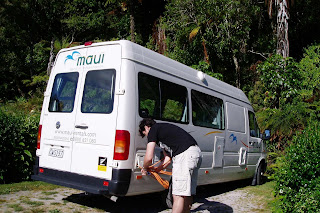 Today we took the boat to White Island, which is New Zealands most active volcano. During the 2 hr boat trip we learnt that the locals pronounce Whakatane as Fukatane (which kept Warwick amused for the boat trip there and back) and also stopped along the way to watch some dolphins swimming alongside the boat. As we got nearer to the island we were issued with a hard hat and gas mask before being loaded into the rubber dingy to get to the shore.
Today we took the boat to White Island, which is New Zealands most active volcano. During the 2 hr boat trip we learnt that the locals pronounce Whakatane as Fukatane (which kept Warwick amused for the boat trip there and back) and also stopped along the way to watch some dolphins swimming alongside the boat. As we got nearer to the island we were issued with a hard hat and gas mask before being loaded into the rubber dingy to get to the shore.

Now if you’re expecting flowing rivers of molten lava (as we might have been) then you’ll be disappointed but the volcano does have 10-12 tremors every day (no we didn’t feel one) and is known to throw out pyroclastic bombs ranging in the size from basketballs to VW Beetles (not sure how effective the hard hat would be). Our guides only recommendation if that was to happen was to run, not to the water as the boat will have moved behind the island but behind something big. The island is basically porous rock and sulphur gas bubbles through until it reaches the surface and jets out through large fumeroles into the atmosphere. Overall the tour was interesting and you get to walk all around the island, get up close to the largest sulphur fumeroles (hence the gas mask) and up to the edge of the most recently generated crater formed during the last eruption in 2000 (there have been several different craters over the life of the island). The crater is filled with sulphuric acid, pH 0.3, although in the past it has been as low as –pH 0.6 (who knew that pH went into the neg?).
 Fumerole spewing out sulphur gas
Fumerole spewing out sulphur gas Volcano crater filled with a milky looking sulphuric acid
Volcano crater filled with a milky looking sulphuric acid Warwick sampling the fresh water on White Island
Warwick sampling the fresh water on White IslandOur English tour guide had been in the position since Oct 2007 and while he knew the spiel well and I thought at the start, maybe he’s a geologist, an expert in volcanoes, but I realised this probably wasn’t the case after he mentioned that he could carbon date the rocky outcrops if he had the equipment and of course the scientific knowledge to do so. Yep lost all credibility with that comment and more. White Island was mined in the 1800-1900’s for sulphur for fertiliser and some of the equipment is still present on the island although its rusting away. In 1917 there was an eruption at night that pushed the mining camp into the ocean – the only survivor was Peter the cat who survived for 3 weeks before being rescued. Mining was shut down on the island in 1934 as the yield was crap (only 40%, they were aiming for 90%).
 Rusted out mining equipment on White Island
Rusted out mining equipment on White IslandAfter arriving back on dry land we got back in the van and headed to Rotorua. This time we scoped out a few caravan parks until we came across one located on Lake Tikitapu, about 6 km out of Rotorua. The lake is surrounded on all sides by steep hills and was perfect for a quick dip to cool down after a long day.

Lake Tikitapu

Warwick setting up camp at Lake Tikitapu
Hair update – one week down, 5 to go. Hair seems to have life of its own, no complains on smell yet.




No comments:
Post a Comment